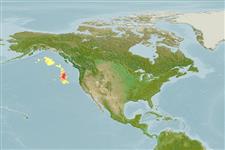>
Ophidiiformes (Cusk eels) >
Bythitidae (Livebearing brotulas)
Etymology: Barathronus: Greek, barathron = abyss + ending -ites, that lives there; the Barathron was a deep pit in Athens where criminals were thrown; 1849 +Greek, onos = hake.
More on authors: Nielsen & Eagle.
Environment: milieu / climate zone / depth range / distribution range
Ecologie
marien bathypelagisch; diepte 3334 - 3860 m (Ref. 34024). Deep-water
Atlantic and Pacific Oceans.
Grootte / Gewicht / Leeftijd
Maturity: Lm ? range ? - ? cm
Max length : 11.6 cm SL mannelijk / geslacht onbekend; (Ref. 121928); 12.8 cm SL (female)
Korte beschrijving
Determinatiesleutels | Morfologie | Morfometrie
Dorsale zachte stralen (totaal) : 63 - 80; Anale zachte stralen: 55 - 72; Wervels: 78 - 89. This species is distinguished by the following characters: a pair of small bulbs at base of penis; with a transparent peritoneum; D 63-80, A 55-72, pectoral-fin rays 22-27; precaudal vertebrae 35-40, total vertebrae 78-89; anterior gill arch with 28-35 long rakers; vomer with 4-8 fangs; small otolith, rounded and thick (Ref. 121928).
Rare species (Ref. 34024).
Levenscyclus en paargedrag
Maturities | Voortplanting | Spawnings | Egg(s) | Fecundities | Larven
Nielsen, J.G., 2019. Revision of the circumglobal genus Barathronus (Ophidiiformes, Bythitidae) with a new species from the eastern North Atlantic Ocean. Zootaxa 4679(2):231-256. (Ref. 121928)
Status op de Rode Lijst van het IUCN (Ref. 130435)
Gevaar voor de mens
Harmless
Gebruik door de mens
Visserij: van geen belang
Tools
Speciale rapporten
Download XML
Internetbronnen
Estimates based on models
Preferred temperature (Ref.
123201): 1.5 - 1.6, mean 1.5 °C (based on 22 cells).
Fylogenetische diversiteitsindex (Ref.
82804): PD
50 = 0.5005 [Uniqueness, from 0.5 = low to 2.0 = high].
Bayesian length-weight: a=0.01000 (0.00244 - 0.04107), b=3.04 (2.81 - 3.27), in cm total length, based on all LWR estimates for this body shape (Ref.
93245).
Trofisch niveau (Ref.
69278): 3.4 ±0.5 se; based on size and trophs of closest relatives
Weerstandsvermogen (Ref.
120179): Hoog, minimale populatieverdubbelingstijd minder dan 15 maanden (Preliminary K or Fecundity.).
Fishing Vulnerability (Ref.
59153): Low vulnerability (10 of 100).
